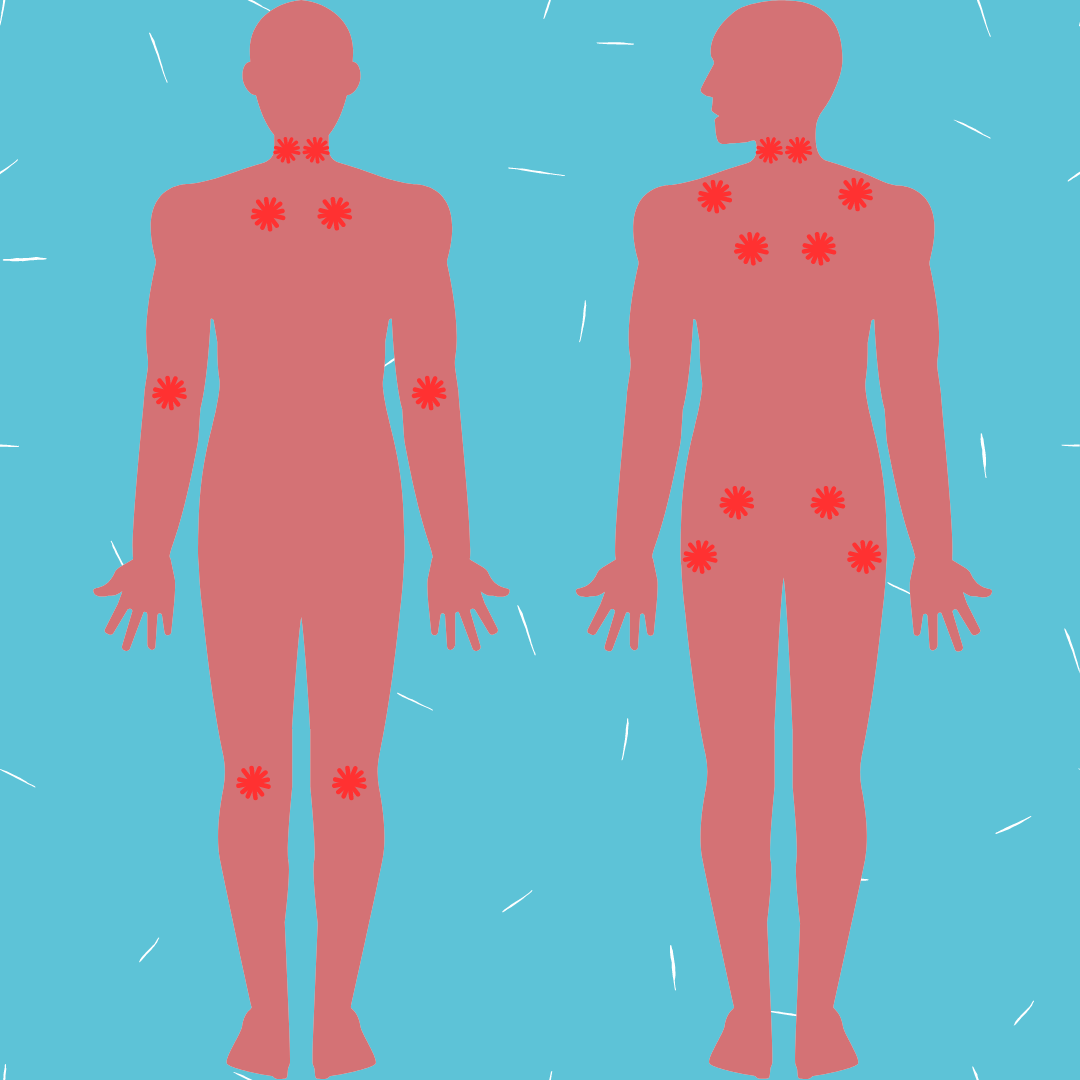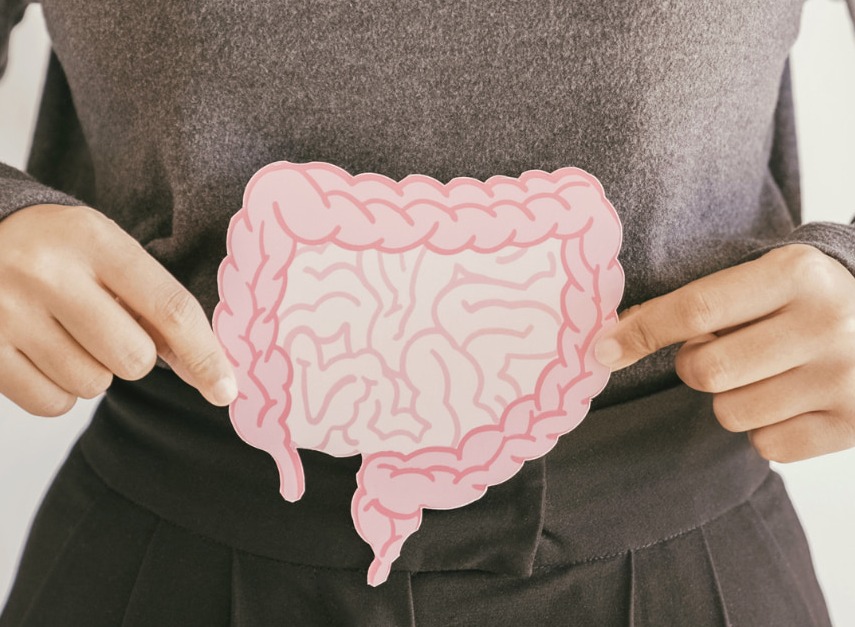Fibromyalgia: What are the 18 pressure points that help in diagnosing?
Published 12 May 2023 • By Polina Kochetkova
Fibromyalgia is a chronic disease that affects more than 1.5 million people in the UK. In this article, we discuss the definition, symptoms, pain points and treatments of fibromyalgia.
Are you preoccupied that you might have fibromyalgia? How to identify the symptoms of fibromyalgia? And how to find the condition’s pain points in your body?
Keep reading to find out!

What is fibromyalgia?
Fibromyalgia is a chronic condition that more than 1.5 million people in the UK struggle with. However, the condition is not fully understood yet, as before doctors were not sure if it was an actual illness at all. Fibromyalgia, or fibromyalgia syndrome (FMS), causes widespread pain all over the body, resulting in fatigue, brain fogginess – fibro fog, sleep problems, depression, and other symptoms. Often the condition is misdiagnosed and mistaken for Lyme disease or depression. The cause of fibromyalgia is yet unknown, however, some of the possible trigger factors can include:
- Physical trauma
- Emotional trauma
- Abnormal response to pain
Fibromyalgia pain can be very sharp, especially during flare-ups. The pain can get worse in the following situations: exercising, experiencing cold weather, and being under stress.
How is fibromyalgia diagnosed?
Usually, when you are in pain, you can quickly identify the cause, whether you stretched a muscle at the gym or cut yourself while cooking, yet for people with fibromyalgia, the process of identifying the cause of pain can be a lot more complex. When experiencing pain on a daily basis without knowing the reason, it can get very frustrating. One of the reasons why it takes so long to diagnose fibromyalgia is due to low awareness of the condition and its symptoms are often overlooked or ignored. Many patients with fibromyalgia describe a long diagnosis process, as it can be confusing even for doctors. Another reason why the diagnosis can take a long time is that there is simply no specific test for fibromyalgia. Medical professionals typically rely on patient-reported symptoms and a physical exam to make a diagnosis.
The diagnosing tests for fibromyalgia include:
- Physical findings at a minimum of 11 out of 18 tender points
- Widespread pain index (WPI)
- Symptoms severity scale score (SS)
Other symptoms of fibromyalgia are: headaches, depression, anxiety, irritable bowel syndrome, and restless legs syndrome. While there is no cure for fibromyalgia, with proper treatment and management, patients can experience a significant reduction of symptoms and life quality improvement. It is important for individuals with fibromyalgia to work closely with their healthcare provider to develop a personalized treatment plan that meets their specific needs. If the symptoms are present for at least three months with no other disorder as a possible cause, fibromyalgia can be diagnosed.
What are the 18 pain points of fibromyalgia?
Hugh Smythe and Harvey Moldofsky, two Canadian doctors, first presented criteria for fibromyalgia based on the discovery of these tender places in 1977, which is when the name "tender points" first appeared.
While fibromyalgia is a disorder known for causing widespread pain, doctors often notice specific body parts in fibromyalgia patients that felt more sensitive to touch than those who don't have this disorder. These areas were called tender points.
Tender points represent regional pain locations that are close to your joints but not in the actual joints. When you press on them, they hurt. Even light finger pressure, such as a poke, might cause someone to shiver or flinch. Doctors use 18 particular locations on the body to diagnose fibromyalgia. Tender points can be found in places such as the back of the head, neck, shoulders, chest, hips, knees, and elbows. When pressure is applied to the tender points, they may become painful, and a patient with fibromyalgia must have pain in at least 11 of these 18 points to be diagnosed with the condition.

(Image: Fibromyalgia pain points)
The levels of pain can vary from patient to patient. Yet with gentle pressure the discomfort in the tender points can be identified.
Although specialists are unsure of the precise cause of these sensitivities in particular parts of the body., John Dombrowski, MD, anesthesiologist and pain management at The Washington Pain Centre in Washington, D.C., claims it is associated with muscle spasms.
According to Dr. John Dombrowski: “When muscles get spasms [involuntary contractions], they tend to have a lack of oxygen and blood. That lack of oxygen and buildup of acid and carbon dioxide causes more pain in the muscles, which causes greater spasms, and it’s a vicious cycle.” Why do muscles have spasms in the first place? “We still don’t know the reason for these spasms and increased sensitivities”. “But what’s causing the pain is a cyclical event.” says Dr. Dombrowski.
Among the 18 fibromyalgia-sensitive spots are:
- Frontal lower neck
- Upper breast edge
- Elbow area of the arm
- Knee
- Hip bone
- Base of the skull near the bottom of the head
- Upper buttock
- Behind the neck
- Shoulders' backs
What to do if you suspect fibromyalgia?
It's crucial to see a medical professional right away if you think you might have fibromyalgia to ensure you are given a correct diagnosis as soon as possible. Visiting your primary care physician is the first step toward knowing whether you have fibromyalgia or not. Your doctor will perform a thorough physical examination and ask about your symptoms. Blood tests may also be requested by the doctor to rule out other disorders like lupus or rheumatoid arthritis which can have similar symptoms.
If your primary care physician suspects that you have fibromyalgia, they may refer you to a rheumatologist or a pain management specialist for further evaluation. These specialists are trained to diagnose and treat fibromyalgia and other chronic pain conditions. They may conduct additional tests, such as a tender point exam, which involves pressing on specific points on your body to see if they are tender or painful.
Lastly, it is important to take care of your overall health by getting enough sleep, eating a healthy diet, and getting regular exercise. Exercise can be especially beneficial for people with fibromyalgia, as it can help reduce pain and stiffness, improve sleep quality, and boost mood and energy levels.
What are the treatment options for fibromyalgia?
Even though fibromyalgia does not put the patient’s life at direct risk, it can still be extremely hard to manage and can cause debilitating reactions. Treatment for fibromyalgia typically involves a combination of medication, exercise, and lifestyle changes. Medications such as Duloxetine, Milnacipran, and Pregabalin can be effective in reducing pain and improving sleep. Physical therapy and exercise can also help improve muscle strength, flexibility, and reduce pain. Lifestyle changes such as stress reduction, healthy eating, and getting enough restful sleep can also help manage fibromyalgia symptoms.
Some of the possible non–medical ways to release fibromyalgia symptoms may include:
- Exercise program designed for fibromyalgia patients
- Physical therapy
- Acupuncture
- Tai Chi
- Yoga
Meanwhile, talking to a therapist can help better manage the illness and cope with possible signs of depression caused by chronic pain. Joining a patient association for fibromyalgia patients can be beneficial to feel more supported while battling this chronic condition. Some of the useful organizations for fibromyalgia patients are FMA UK and Pain UK.
Give it a "Like" and share your thoughts and questions with the community in the comments below!
Take care!

 Facebook
Facebook Twitter
Twitter


